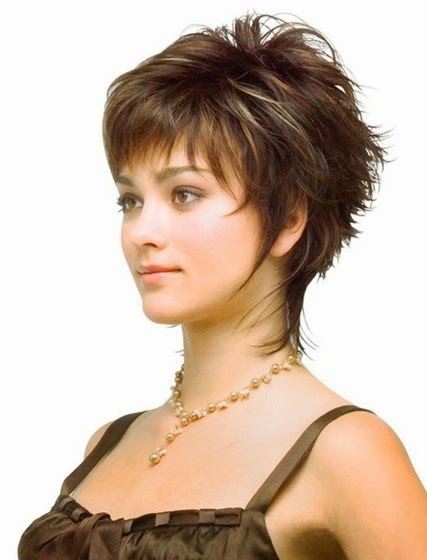 Short Haircuts for Women: Short Hair Styles 2015 PoPular Haircutshttp://pophaircuts.com/images/2014/12/Michelle-Williams-Short-Hair-Style-Celebrity-Pixie-Haircuts.jpg
Short Haircuts for Women: Short Hair Styles 2015 PoPular Haircutshttp://pophaircuts.com/images/2014/12/Michelle-Williams-Short-Hair-Style-Celebrity-Pixie-Haircuts.jpg
Hottest Short Hairstyles Women
A hairstyle, hairdo, or haircut refers to the styling of mane, usually on the real human scalp. Sometimes, this could also mean an editing of beard hair. The fashioning of hair can be viewed as an element of personal grooming, fashion, and cosmetics, although practical, cultural, and popular considerations affect some hair styles also. The oldest known depiction of hair braiding dates back about 30,000 years. In traditional civilizations, women's wild hair was often elaborately and carefully dressed in special ways. In Imperial Rome, women used their mane in complicated styles. From enough time of the Roman Empire[citation needed] until the Middle Ages, nearly all women grew their mane so long as it would obviously expand. During the Roman Empire as well as in the 16th century in the western world, women commenced to wear their hair in extremely ornate styles. Within the later half of the 15th century and on in to the 16th century a very high hairline on the forehead was considered attractive. Through the 15th and 16th decades, European men wore their mane cropped no than shoulder-length longer. In the first 17th century male hairstyles grew longer, with waves or curls being considered desirable.
The male wig was pioneered by King Louis XIII of France (1601-1643) in 1624. Periwigs or perukes for men were created into the English-speaking world with other French styles in 1660. Late 17th-century wigs were very long and wavy, but became shorter in the mid-18th century, where time they were normally white. Short hair for fashionable men was a product of the Neoclassical movement. In the early 19th hundred years the guy beard, and also moustaches and sideburns, made a strong reappearance. In the 16th to the 19th century, European women's scalp became more noticeable while their locks coverings grew smaller. In the center of the 18th century the pouf style developed. Through the First World Battle, women around the world started to shift to shorter hairstyles that were simpler to manage. In the first 1950s women's hair was generally curled and worn in a number of styles and lengths. In the 1960s, many women commenced to wear their head of hair in short modern cuts such as the pixie cut, while in the 1970s, hair tended to be much longer and looser. In both the 1960s and 1970s many men and women wore their hair very long and straight. Within the 1980s, women pulled back their hair with scrunchies. During the 1980s, punk hair styles were adopted by some people.
Throughout times, folks have worn their wild hair in a multitude of styles, largely determined by the fashions of the culture they live in. Hairstyles are signifiers and markers of social class, age, marital status, racial identification, political beliefs, and attitudes about gender.
In many cultures, for religious reasons often, women's locks is protected while in public, and in a few, such as Haredi Judaism or Western european Orthodox areas, women's mane is shaved or minimize very short, and covered with wigs.Only because the end of World Warfare I have women begun to wear their mane brief and in fairly natural styles.
Paleolithic
- The oldest known duplication of head of hair braiding lies back again about 30,000 years: the Venus of Willendorf, known in academia as the girl of Willendorf now, of a lady figurine from the Paleolithic, estimated to own been made between about 28,000 and 25,000 BCE.The Venus of Brassempouy counts about 25,000 yrs . old and indisputably shows hairstyling.
Bronze Age
- In Bronze Era razors were known and used by some men, however, not on a regular basis since the technique was rather unpleasant and required resharpening of the tool which reduced its strength.
Ancient history
- In historical civilizations, women's wild hair was often elaborately and carefully dressed in special ways. Women coloured their hair, curled it, and pinned it up (ponytail) in many ways. They place their mane in waves and curls using moist clay, which they dried out in the sun and combed out then, or else by by using a jelly made of quince seeds soaked in normal water, or styling tongs and styling irons of varied kinds.
Roman Empire and DARK AGES
- Between 27 BC and 102 Advertising, in Imperial Rome, women used their locks in complicated styles: scores of curls at the top, or in rows of waves, drawn back to ringlets or braids. Eventually noblewomen's hairstyles grew so complex that they required daily attention from several slaves and a stylist in order to be maintained. The locks was lightened using timber ash, unslaked lime and sodium bicarbonate, or darkened with copper filings, oak-apples or leeches marinated in vinegar and wine beverage. It had been augmented by wigs, hairpieces and pads, and held in place by nets, pins, pomade and combs. Beneath the Byzantine Empire, noblewomen covered the majority of their hair with silk pearl and caps nets.
Best Hair Styles For Short Hair Women
- It is vital to find the best short hairstyles for ladies since it performs an enormous part of your look. Having the right hairstyle provides you with joy and positive feelings. Find out which hairstyle is perfect for your character and personality. You should also consult your hairstylist before having a new haircut. After all, changes are excellent and it can truly add positive perspective in your daily life also. Feel absolve to browse our assortment of short hairstyles for females and select the one that your like best.
Hot Easy Short Hairstyles for Women
 http://www.circletrest.com/wp-content/uploads/2013/07/Hot-Easy-Short-Hairstyles-for-Women.jpg
http://www.circletrest.com/wp-content/uploads/2013/07/Hot-Easy-Short-Hairstyles-for-Women.jpgThe Best Short Hairstyles for Women 2015 Women Daily Magazine
 http://a3559z1.americdn.com/wp-content/uploads/2015/02/The-Best-Short-Hairstyles-for-Women-2015-1.jpg
http://a3559z1.americdn.com/wp-content/uploads/2015/02/The-Best-Short-Hairstyles-for-Women-2015-1.jpg27 Best Short Haircuts for Women: Hottest Short Hairstyles PoPular
 http://pophaircuts.com/images/2014/03/2014-Short-Haircuts-for-Women.jpg
http://pophaircuts.com/images/2014/03/2014-Short-Haircuts-for-Women.jpgwomen ideal hairstyles sexy short hairstyles short hairstyles short
 https://blogger.googleusercontent.com/img/b/R29vZ2xl/AVvXsEiZtV536ntkrnIonnVcgQtqJEyl0H0WxPGGSv_GRq6XauriwNSCtL32wb0bZPRnazJENMZtYNWpR9q2uq74g3nba1-IQ7vQvR7Fd1wVjcSSxT0XzteRPliWPIGNL51GfyAyz9VpOBUE78s/s1600/Look+Sexy+With+Short+Hairstyles+For+Women.jpg
https://blogger.googleusercontent.com/img/b/R29vZ2xl/AVvXsEiZtV536ntkrnIonnVcgQtqJEyl0H0WxPGGSv_GRq6XauriwNSCtL32wb0bZPRnazJENMZtYNWpR9q2uq74g3nba1-IQ7vQvR7Fd1wVjcSSxT0XzteRPliWPIGNL51GfyAyz9VpOBUE78s/s1600/Look+Sexy+With+Short+Hairstyles+For+Women.jpgOIP.M9b6094bd06e7b413cbb1a3142055483eo1
22AEC50022351D6FCFE9DC1F6042E1FD90CFC431F8http://pophaircuts.com/40-pretty-short-haircuts-women-short-hair-styles-2015
Embed Our image to your website
ThumbnailImageEmbed Our image to a Forum
ThumbnailImage








.jpg)
.jpg)

